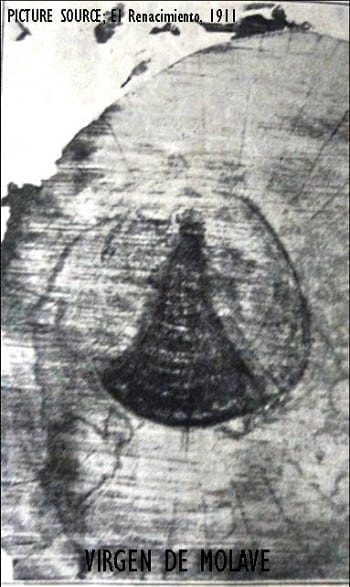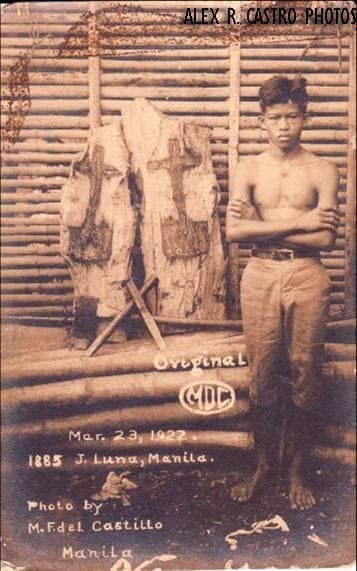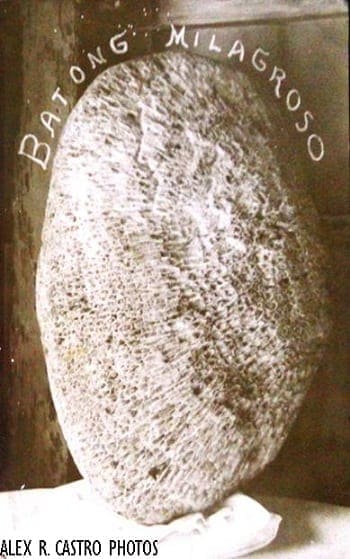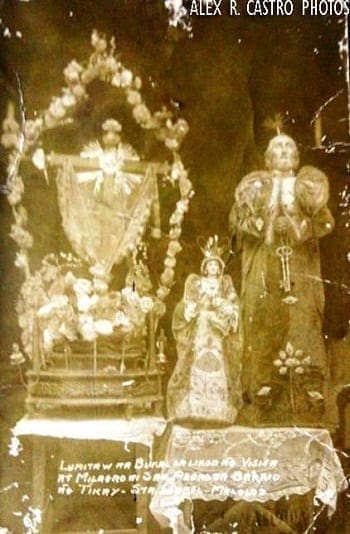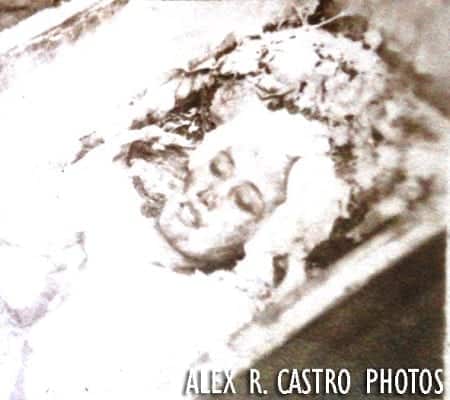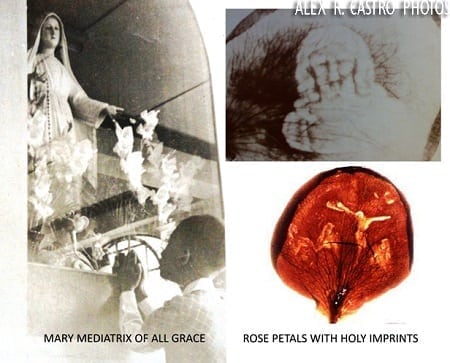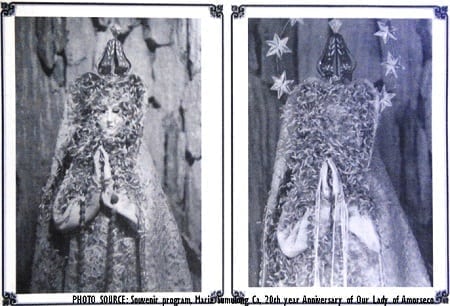9 Astonishing Miracles and Apparitions in Philippine History
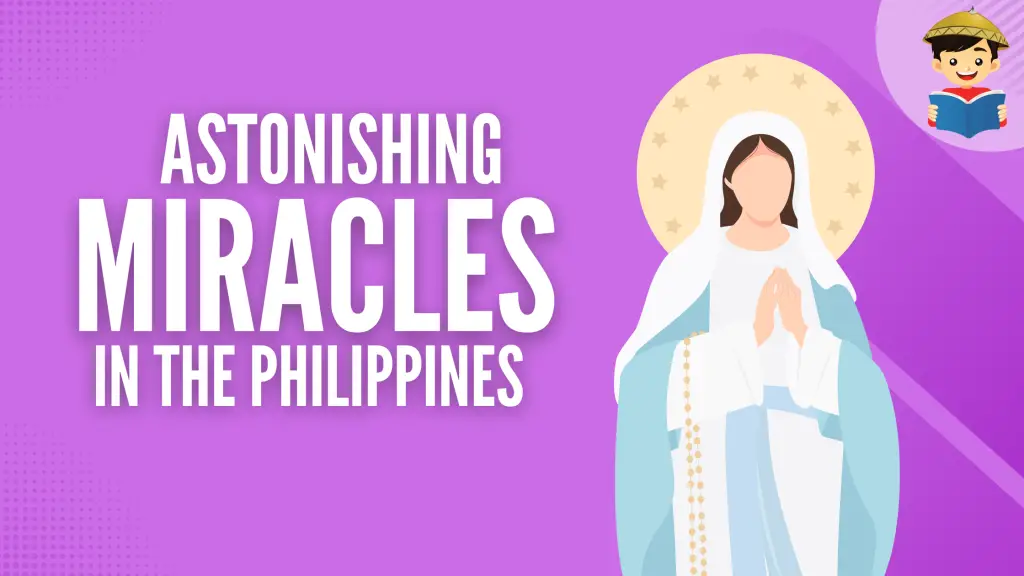
Miracles are nothing new to Filipinos, even before Christianity reached our islands.
Miraculous healings were provided by mediums called babaylans and catalonans, who called on spirits to cure illnesses and plagues of all sorts. Ancient Filipinos sought supernatural protection through anitos. Apparitions of diwatas and underworld creatures were common beliefs in animism.
Read: 9 Things You Didn’t Know About The Catholic Church In The Philippines
When a new religion was introduced, miracles seemed to prosper even more—with new, more powerful “deities” like the Blessed Virgin, Jesus, and a host of saints ready to work wonders and come to our succor. Here is a list of more contemporary miracles involving visions, unexplained appearances of holy pictures, and religious statuaries behaving strangely.
1. Nuestra Señora de Molave (Sta. Cruz, Laguna)
In the first decade of the 20th century, a man from Sta. Cruz decided to saw off a mulawin (molave) trunk to make a post for his house. To his astonishment, the trunk’s core revealed what appeared to be the Blessed Virgin’s silhouette. The post was used for the house, and the sawed-off ends containing the image were kept in the house.
Thus began a series of inexplicable events in the new house. In two instances, the occupants were roused from their sleep by a woman’s voice, thus saving the family–first, from a house fire, and second, from an attempted burglary.
Word of the miracles spread throughout Laguna, causing a tree-chopping frenzy among the locals hoping to find their image of the Virgin. There were offers from a priest to buy the miraculous post for PHP 3,000 (which was refused) and from the Aglipayans to build a church. After some years, interest died down, and today, the Virgen de Molave is enshrined at the Parish of Our Lady of Maulawin in Sta. Cruz, Laguna.
2. Kambal na Krus (Tondo, Manila)
On March 23, 1922, Crispino Lacandaso was chopping wood from a felled, century-old sampalok tree on a vacant lot at 1885 Juan Luna Street, Gagalangin, Manila. After much difficulty, the young laborer cleaved the trunk in two. To his amazement, he saw a dark cross on a base, imprinted on both halves of the wood.
The discovery of the twin crosses was considered a miracle and instantly created a sensation among devout Catholics in the area. The pieces of wood were subsequently encased in glass and later installed in a small chapel built as a shrine where devotees could come to venerate the sacred twin crosses, especially during Holy Week.
3. Batong Milagroso (Cavite)
Stones imbued with strange powers are not unknown to early Filipinos who kept them as talismans and amulets. Tektites (tae ng bituin) found favor as anting-antings because of their stellar origins. Why, even the powers of Pinay wonder woman Darna depended on a pebble placed in the mouth of her alter-ego, Narda (“Ding! Ang bato!).
Folk Christianity gave us not only religious medals but also strange objects touched by divinities. In 1901, for example, residents of Cavite Viejo went agog over a Laguna faith healer who had healing stones reputedly stained with the blood of Jesus. Similarly, this 1920s “Batong Milagroso” is revered for bearing the profile of Christ.
In June 2008, a healing stone bearing the image of the Virgin Mary was found in Catanduanes. It is now housed at the chapel of Our Lady of Sorrows at Barangay Paloay.
4. Miraculous Spring of Tikay (Malolos, Bulacan)
In the early 1920s, there stood a visita (small chapel) at Barrio Tikay of Sta. Isabel, Malolos, Bulacan. A spring with waters of supposedly curative nature gushed out at the back of the chapel, which was deemed as a miracle attributed to San Pedro, the patron of the barrio, a dressed image of which was enshrined at the visita.
The barrio became a popular site for local pilgrims until the spring dried out. In 1964, a new barrio—San Pablo—was carved out of the Tikay district, and today, very few remember the miraculous spring that recalled the supernatural event in Lourdes, France, many decades before.
5. The Incorruptible Filomena Almarinez (Biñan, Laguna)
In a Biñan cemetery lies the body of a woman who defied the ravages of death—Filomena Almarinez (July 6, 1913 – August 13, 1938). Born to a farming family, Filomena was said to be a saintly young woman, prone to introspection. Sadly, she died at the young age of 25, allegedly due to emotional stress.
When her father died in 1947, Filomena’s tomb was opened so it could be cleared of her remains to give way to her father’s body. Workers were surprised to find her body undecayed, her face as fresh as the day she was buried, and even her burial dress intact. Immediately, people proclaimed her a saint, and devotees trooped to her tomb, where miracles were allegedly wrought (e.g., candles melted on her tomb to form the face of Jesus). A local cult quickly developed and persisted till the early 50s.
Filomena continues to rest at the Biñan cemetery, now renamed Sta. Filomena Cemetery. Oldtimers and tourists intrigued by her story continue to visit the tomb of this “marilag na paraluman at milagrosang santa ng Biñan, Laguna.”
6. Holy Faces on Rose Petals (Lipa and Bulacan)
In 1948, the Blessed Virgin reportedly appeared to 21-year-old Teresita Castillo, a postulant at the Carmelite convent in Lipa, Batangas. The manifestation was followed by a mysterious shower of rose petals with imprints of religious characters like the Sacred Heart, the Holy family, the Virgin and Child, Joseph, and Jesus.
Then Bishop of Lipa Alfredo Verzosa permitted the veneration of the Virgin’s image—Mary, Mediatrix of All Grace. However, in December 2010, the Vatican finally ruled that the apparitions were not supernatural. Still, many in the Church believe that the 19 Lipa apparitions were authentic, and the rose petals that have been kept by devotees remain as tangible proofs of this much-publicized local Marian miracle.
Also Read: Top 10 Unsolved Mysteries in the Philippines
A similar event involving rose petals imprinted with the religious figure was reported on June 12, 1991, when Carmelo Cortez allegedly witnessed a vision of a lady dressed in white, with the Holy Eucharist on her bosom, holding a rosary and Carmel Scapular on each hand.
A shrine was built in Brgy. San Vicente, Sta. Maria, Bulacan, where Cortez conducts his healing missions, held every first Saturday of the month. During these sessions, he touches rose petals causing images to appear, that many faithful believed to be of divine origin.
7. Our Lady’s Alleged Apparition (Cabra, Mindoro)
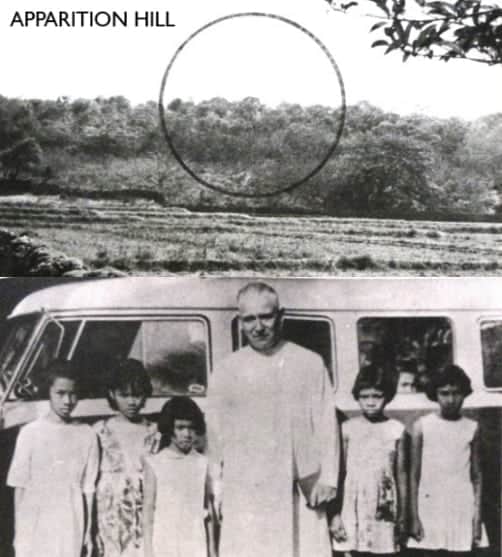
Between 1966 and 1972, on a rocky hillock called Burol, located in Cabra Island of Lubang, Mindoro, the Blessed Virgin reputedly appeared before eight girls and introduced herself as the “Immaculate Conception.”
The first apparition was witnessed by 10-year-old Belinda Villas, daughter of a farmer-fisherman, on December 6, 1966. Returning there the next day to investigate, Belinda and her 7 friends—Mercilita Cajayon, Dalisay Tameta, Edna Villas, Matilda Somintac, Mindadelia Tulaylay, Erlinda Villas, and Gloria Tulaylay—all witnessed the Lady appear and stand before them in mid-air.
News of the apparition spread after the girls told their teachers and parents of this extraordinary encounter with the “mother of Jesus.” In the succeeding visitations, the Lady left them with several messages to pray the rosary and to do penance. The most awaited was a promised miracle on March 25, 1968.
On that day, many of the 7,000 pilgrims who came to Cabra claimed to have seen the Virgin appear at 4:30 AM, and several eyewitness accounts include visions of the “sun turning and changing its colors,” “a bright star on top of the tree near the chapel,” “the rising sun with little tongues of flame around it,” and “spinning like it was coming towards the people.”
The apparitions lasted until March 25, 1972. The visionaries by then were living separate lives—some, like Belinda and Mercilita, found jobs in Manila; others chose to remain in Cabra. As the country plunged into political turmoil, the public lost interest in the Cabra apparitions, which have yet to be recognized by the Church.
8. The Weeping Lady of Amorseco (San Fernando, Pampanga)
In September 1987, Mrs. Rosalio C. Toledano of San Fernando traded a small image of Our Lady in exchange for fabrics with dry goods dealer Lhoree Lee. The next month, strange events attended the transfer of the image to the Lee residence. Her family started smelling the scent of roses and candles, which they first dismissed. But on October 9, amor-seco (cogon flowers) began appearing and sticking to the hair of their Marian image until the whole face and vestments were covered.
Read: 7 Most Unintentionally Terrifying Statues In The Philippines
On October 13, the tiny statue began to weep. Lee, believing that these were divine signs, consulted with then Archbishop Oscar Cruz on the matter. Meanwhile, people started coming in droves to see the Virgin—now known as Our Lady of Amor-seco. The Virgin also began sending messages through the school caretaker, Romeo G. Pabustan, who has since become her medium.
The miraculous image is enshrined at Our Lady of Amorseco House of Prayer, which has become a center for outreach programs and many religious crusades.
9. The Healing Oil of Santo Niño de la Providencia (Las Piñas)
In 1986, Corazon Gonzales of Las Piñas bought a wooden Sto. Niño image from a religious shop in Tayuman, Sta. Cruz, Manila. She placed the 2-foot image on top of an electric organ in their living room, and there it remained until January 27, 1992—when her daughter Lorna found the image on the floor oozing oil.
Recommended Article: 9 Surprising Facts About Papal Visits To The Philippines
The oil was discreetly collected, bottled, and given away to people visiting the Sto. Nino. Soon, the news spread by word of mouth, and the media began reporting the healing oil of the Sto. Niño de la Providencia.
Case stories of people cured of serious diseases—ranging from end-stage cancer, mental retardation, and nerve problems to dengue fever and amputation—were collected and examined, baffling even doctors and medical experts. A chapel has been built beside the house to accommodate the faithful seeking succor, comfort, and miracles to their life’s afflictions.
References
Albano, T. (1978). The Apparitions of Cabra Islet, Philippines (p. 210). Alver Tied Charities and Cultural Circle.
Castro, A. (2013). Santo Stories: Sta. Filomena, Biñan’s Incorruptible Saint. And All The Angels And Saints. Retrieved 4 August 2015, from http://goo.gl/rHnW1y
El Renacimiento,. (1911).
Florendo, A. (2001). Santo Niño: the Holy Child Devotion in the Philippines (pp. 114-115). Manila: Congregacion del Santisimo Nombre del Niño Jesus.
Keithley, J. (1992). Lipa (pp. p. 70-71). Mandaluyong, Metro Manila: Cacho Publishing House, Inc.
Ricio, N., & Cordero-Fernando, G. (1978). Turn of the Century (pp. p. 169-171). Quezon City: GCF Books.
Written by Alex R. Castro
in Bizarre & Oddities, Facts & Figures, History & Culture, Politics & Religion
Last Updated
Alex R. Castro
Alex R. Castro is a retired advertising executive and is now a consultant and museum curator of the Center for Kapampangan Studies of Holy Angel University, Angeles City. He is the author of 2 local history books “Scenes from a Bordertown & Other Views” and “Aro, Katimyas Da! A Memory Album of Titled Kapampangan Beauties 1908-2012”, a National Book Award finalist. He keeps 2 pop culture blogs: “Views from the Pampang” (2009 Philippine Blog Awards finalist) and Manila Carnivals 1908-1939. He is a 2014 Most Outstanding Kapampangan Awardee in the field of Arts. For comments on this article, contact him at [email protected]
Copyright Notice
All materials contained on this site are protected by the Republic of the Philippines copyright law and may not be reproduced, distributed, transmitted, displayed, published, or broadcast without the prior written permission of filipiknow.net or in the case of third party materials, the owner of that content. You may not alter or remove any trademark, copyright, or other notice from copies of the content. Be warned that we have already reported and helped terminate several websites and YouTube channels for blatantly stealing our content. If you wish to use filipiknow.net content for commercial purposes, such as for content syndication, etc., please contact us at legal(at)filipiknow(dot)net

